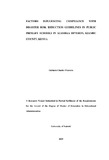| dc.description.abstract | The purpose of the study was to investigate factors influencing compliance
with disaster risk reduction guidelines in public primary schools in Kiambaa
Division, Kiambu County, Kenya. The study aimed to achieve this by assessing
the extent to which school size, structural condition of physical infrastructure,
availability of financial resources and community participation influenced
compliance with disaster risk reduction guidelines. Abraham Maslow’s
Hierarchy of Needs Theory was reviewed. The study adopted a descriptive
survey design. The target population was 23 headteachers and 372
teachersfrom 23 public primary schools in Kiambaa Division. The study
sampled 21 headteachers. To get a total of 189 teachers, nine teachers were
picked randomly from each of the 21 public primary schools in the Division.
Questionnaires for the headteachers and teachers and an observation schedule
were used to collect information on factors influencing compliance with
disaster risk reduction guidelines.Descriptive statistics including percentages
and frequency counts were used to analyse the quantitative data obtained. Data
was presented in form of tables, graphs and pi-charts. The study found out that
no school in Kiambaa Division had fully complied with disaster risk reduction
guidelines as confirmed by all the headteachers and all the teachers. All the
respondents confirmed that there was congestion in their schools which posed a
challenge to compliance with disaster risk reduction guidelines. The physical
infrastructure in 85.7% of the schools was in fair condition. The doors open
outwards and there was enough lighting. However, windows were grilled as
witnessed in all the schools which poses a safety threat in case of a disaster.
Professionals like architects, quantity surveyors, contractors, Ministry of Public
works and Ministry of Health were not involved in the construction and
maintenance of school physical infrastructure as recommended in the Safety
and Standards Manual for Schools (2008) by the Ministry of Education.
Schools in the study had financial difficulties. The government does not
provide money for disaster risk reduction in primary schools as confirmed by
all the headteachers. Majority of the headteachers (81.0%) and a majority of
the teachers (81.0%) were of the opinion that lack of financial resources
affected compliance with disaster risk reduction guidelines. There was poor
rapport between the schools and the community as confirmed by 52.7% of the
teachers. The study concluded that school size, lack of financial resources and
poor school-community relationship are a threat to children’s safety in schools.
The study recommended expansion of the existing school facilities to ease
congestion. School administrators should raise the level of awareness of
disaster risk reduction issues among the teachers. Healthy working relationship
with the community should be fostered so as to be able to involve the
community in disaster risk reduction programmes.The Ministry of Education
should enforce school safety programmes by ensuring all schools institute
school safety sub-committees to implement safety policies. | en_US |

